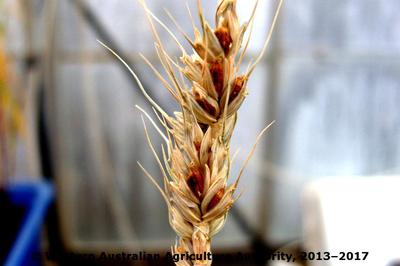Common Bunt of Wheat
Tilletia tritici
Jamur
Ringkasan
- Greasy spikelets with dark green casts.
- When squeezed, kernels reveal black spores which smell like rotten fish.
- Stunted growth.
- Spikes might show reduced awns.
Dapat juga ditemukan di
Gejala
The earliest evidence of infection occurs shortly after pollination of the flowers. Infected spikelets appear greasy with a dark green cast. The seed coat is undamaged, but the inside has been replaced by a black powdery "bunt ball". These kernels are about the same shape and size as usual, but are gray-brown in color. When squeezed, they reveal a mass of black spores that smell like rotting fish. Infected wheat plants may be slightly shorter than healthy plants. Their heads may have shorter awns, or even no awns. Usually, all grains of a spike are affected, but possibly not all spikes on a plant are infected.
Rekomendasi

Pengendalian hayati
Treating the fields with skimmed milk powder, wheat flour or powdered seaweed mixed with water can almost entirely eliminate T. caries. Seed treatments with warm water (45°C) for 2h before sowing eliminates the spores.

Pengendalian kimiawi
Always consider an integrated approach with preventive measures together with biological treatments if available. Contact and systemic fungicides (moving into and inside of the developing seedling) like tebuconazole, benzimidazoles, phenylpyrroles and triazoles are effective in protecting the seeds from T. caries.
Apa penyebabnya?
The symptoms are caused by the fungus Tilletia caries, that persists as dormant spores on seeds and in the soil for up to two years. In areas where spores survive in the soil, most infections originate from the very early stages of plant growth, just after germination. The fungus can also infect young wheat shoots just before they emerge from the soil via infectious hairs. They then gradually colonize the internal tissues of the plant as it grows, eventually reaching the inflorescences and grains. Some of the smutted wheat kernels break open during harvest and release new spores that are blown away by air currents onto the soil to start a new cycle. The rest of the seeds get harvested and can act as vectors for future infections. Optimum conditions for spore germination are soil temperatures in the range of 5-15 °C.
Tindakan Pencegahan
- Planting winter wheat early when the soil temperature is above 20°C results in almost no infection.
- Also, plant summer wheat as late as possible.
- Use resistant varieties and check the seeds for proper certification.
- Rotate crops accordingly.
- Use sterile agricultural tools when working between different fields.



